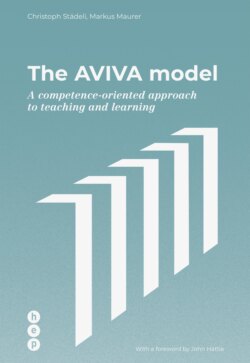Читать книгу The AVIVA model (E-Book) - Manfred Pfiffner, Markus Mäurer - Страница 4
На сайте Литреса книга снята с продажи.
ОглавлениеForeword
My major claim in Visible Learning research is that achievement is maximised when teachers see learning through the eyes of the student and when students are taught to become their own teachers. The AVIVA model is an excellent example of how to put these ideas into action. It balances the involvement and direction of the teacher with the opportunities for students to explore, see errors as opportunities for learning and learn to think as teachers. Students learn to know what to do when they do not know what to do.
The model notes the many interpretations of ‘learning’ and specifically asks teachers to consider the cognitive and other strategies needed by students in any lesson, to distinguish between surface and deep strategies and mandates that teachers teach students various strategies alongside the content of the lesson. In our own work, we speak of “teachers are to DIIE for” (Diagnose, Intervene, Implement and Evaluate), and this is mirrored in the AVIVA model. Arriving and engaging highlight the importance of excellent diagnosis about what the student brings to the lesson in terms of prior skills, their will and their thrill (motivations) and how it is critical to activate prior knowledge. The critical decisions are to choose high probability interventions (informing), attend to the fidelity of implementation (processing) and apply skills in evaluation as to the impact on student learning. Yes, learning is hard work, requires perseverance and skills (in content, relating ideas and having various learning strategies such that if the first does not work they have alternative strategies) and requires skills to be accomplished alone and in groups with the teacher and with peers.
AVIVA is a way of thinking as well as a method of planning – and thus sits ‘above’ many teaching methods. These methods are used to illustrate this way of thinking throughout this book, inviting educators to focus more on their impact on students than on whether or not their methods are implemented (they may be well implemented but have little impact on learning!). Thus, the focus should be less on ‘how teachers teach’ and more on ‘the impact of their teaching’. We also need more ways of thinking about how students grow, such as understanding the students’ extent and use of various learning strategies, their skills of perseverance, as well as their ability to consolidate knowledge, relate ideas and transfer to near and far new problems and situations. I find it fascinating that many 5-year-olds can do this, but by the age of 8 too many children think their role is to come to class and watch the teacher work. AVIVA turns this on its head and helps educators see their impact through the eyes of students and enables students to become their own teachers.
AVIVA is also a Hebrew name meaning youthful, so there is much more to come as this model is implemented, grows in its evidence base and refines and enhances its reach. This book is a wonderful start for educators to learn more about the model, to see beyond the methods and to impact in worthwhile ways on the learning lives of students.
John Hattie
Laureate Professor at the Melbourne Graduate School of Education and Chair of the Board of the Australian Institute for Teaching and School Leadership
